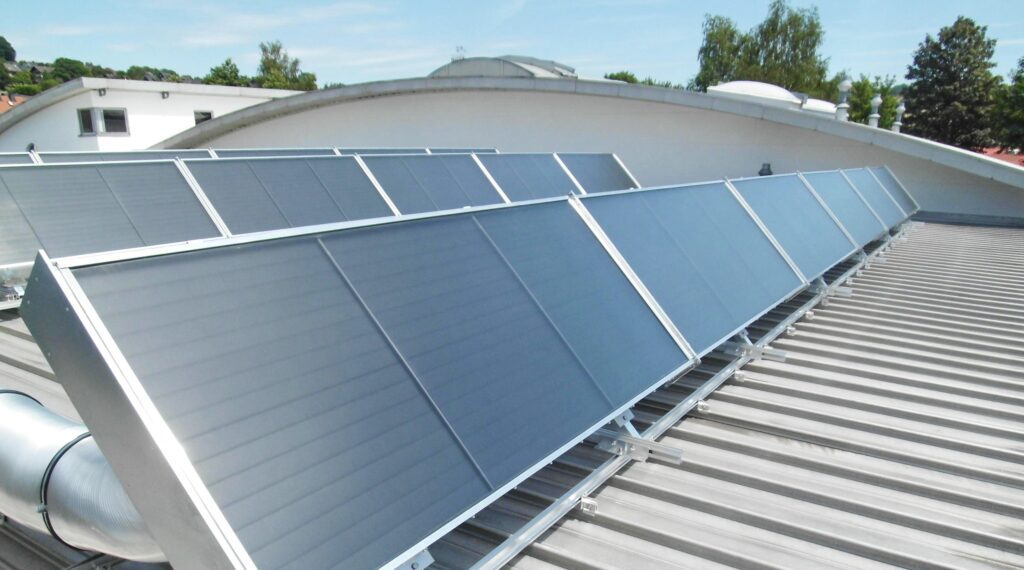Solar ventilation
You want an automatic ventilation system that does not consume electricity? With the self-sufficient solar ventilation from Grammer®Solar you improve the indoor climate and reduce heating costs at the same time.

Homepage › Solar ventilation
Ecological solar ventilation
That there is such a thing! Ventilation, air conditioning, heating and drying all in one - and at zero cost! The system is called Grammer® Solar. Ventilation powered by the sun ensures a healthy indoor climate and pleasantly low heating costs.
The maintenance-free, efficient system has proven itself many times over in vacation homes, chalets, mountain and hunting lodges, camping homes, permanently used caravans, mobile homes, etc., but cellars and garages also benefit from solar heating and drying.
Grammer® Solar has been producing air collectors in Germany for over 40 years and is the first ever Solar Keymark-certified manufacturer of solar air collectors in Europe. The Keymark certifies compliance with European standards.


Our services
- Planning and dimensioning of solar ventilation
- Delivery of the air collectors
- Optional equipment of solar ventilation with night ventilation option
Your advantages
- Ventilation and temperature control with the power of the sun, without electricity costs
- Pleasant indoor climate and reliable protection against moisture and mold
- Lower heating costs, no operating costs, hardly any maintenance (only filter change)
- Simple and fast assembly

The solar ventilation systems from Grammer® Solar are also suitable for larger properties [Source image 2.].

Contact us without obligation
Do you have any further questions or may we prepare an offer for you?
Get in touch with us without obligation. We look forward to your inquiry!
Get in touch with us without obligation. We look forward to your inquiry!
Tobias Bayer
Managing Director

Questions & Answers
- General
- Costs
- Functionality
- Application area
- Procedure
What is solar ventilation?
A distinction must be made between solar ventilators, which work with solar power, and solar air collectors, which use the sun's energy to heat air and feed it into a building for heating and ventilation purposes. We offer solar air collectors from Grammer® Solar.
What is the cost of solar ventilation?
We offer solar ventilation from Grammer® Solar from EUR 1,500 - 2,000 per square meter of solar surface. The exact price depends on the number and size of the solar air collectors, the accessibility of the installation site and the duration of the journey. Ask us without obligation for an individual offer.
What are the advantages and disadvantages of solar ventilation?
Solar air collectors provide automatic ventilation of the building, entirely without incurring electricity costs. The solar heated air creates a comfortable indoor climate and leads to lower heating costs during the cool seasons. The system is considered to be very reliable in operation with low maintenance requirements.
Who is Haustrocknung.de?
How much does solar ventilation cost?
Solar ventilation from Grammer® Solar is available from EUR 1,500 - 2,000 per square meter of solar surface. This includes the entire order processing. The actual price depends on the size and number of air collectors, the accessibility of the installation site and the duration of our journey.
What are the electricity costs of solar ventilation?
Solar ventilation from Grammer® Solar is completely self-sufficient because it produces the electricity for the fans itself. If the system is equipped with the night ventilation option, electricity costs of EUR 25 per year can be incurred for night ventilation.
How does solar ventilation affect heating costs?
Solar ventilation conducts free solar heat into the house and thus leads to lower heating costs.
What maintenance costs and expenses should I expect?
Apart from the filter change, which should be carried out once or twice a year, the system is completely free of maintenance costs and expenses.
How does solar ventilation work?
The solar and air collector from Grammer® Solar generates electricity and uses it to power a fan. This draws in air, which first passes through a filter, is then heated in the air collector and then circulates throughout the house. The free solar heat creates a healthy and comfortable indoor climate, prevents mold and keeps the house dry. As soon as the desired room temperature is reached, the system switches itself off.
What can solar ventilation do?
The standard version of Grammer® Solar solar ventilation automatically brings warm air into the house. This leads to a comfortable indoor climate, reduces heating costs and reliably protects against moisture and mold in the house. In addition, the ventilation system can be optionally retrofitted with a night ventilation set, whereby the ventilation is connected to the house's power supply. This allows the house to be cooled with cool night air on a timed basis and ventilated under user control as required.
Does solar ventilation filter pollutants from the air?
Yes, the aspirated air first passes through a filter before entering the house. This filter should be replaced once or twice a year. Apart from that, the system does not cause any maintenance expenses.
What is the maximum ventilation capacity of the air collectors?
The air collectors from Grammer® Solar supply up to 125 m³ of air per hour into the building. Incidentally, the system also ventilates when the sky is cloudy.
For which buildings is solar ventilation suitable?
Grammer® Solar is suitable for residential houses, vacation homes, mobile homes, garden sheds, greenhouses and individual areas such as cellars or screeds. Thanks to its temperature-controlling effect, the ventilation system is particularly practical for houses that are not occupied for several weeks. In addition to residential buildings, the system can also be used in commercial or agricultural buildings.
Where are the solar air collectors mounted?
The air collectors are mounted on flat roofs, pitched roofs or on facades - either flat or at an angle. The ideal location should receive as much sunlight as possible and have no partial shading.
How noisy is solar ventilation?
The operation of solar ventilation is virtually silent.
How do I control the solar ventilation?
The ventilation system controls itself via a thermostat. As soon as the desired temperature is reached, the system switches itself off. If the night ventilation option is in use, the system is time-controlled.
What is the procedure for installing solar ventilation?
After the initial consultation, we will provide you with a quote tailored to your property. If you accept this, the air collectors will be installed on the roof, façade or other suitable location as agreed. Where necessary, holes are drilled for the ventilation pipes. In certain cases, a lifting platform may be necessary for the installation.
How long does it take to install solar ventilation?
The installation of solar ventilation usually takes one day. The duration of the installation depends on the accessibility of the location where the collectors are to be installed, as well as the number and size of the solar air collectors.
What is the lifetime of solar ventilation?
Grammer® Solar estimates the service life of its solar air collectors to be at least 25 years. The collectors are certified in accordance with the collector standards DIN EN ISO 9806 and DIN EN 12975-1 and have been manufactured in Germany for over 40 years.
How the solar air collector works

- As soon as the collector receives enough sunlight, the fan automatically turns on.
- Fresh outside air is drawn in via a filter and passed through the insulated air collector, heating the air by up to 40°K.
- The warm air then enters the building via an insulated pipe.
- The humid, stale air is discharged outside through exhaust vents. [1.]